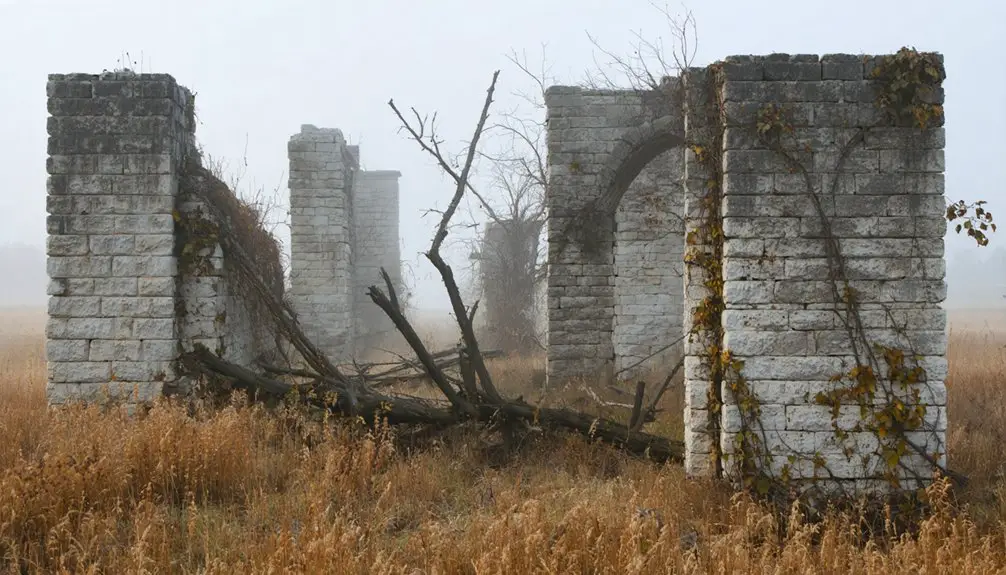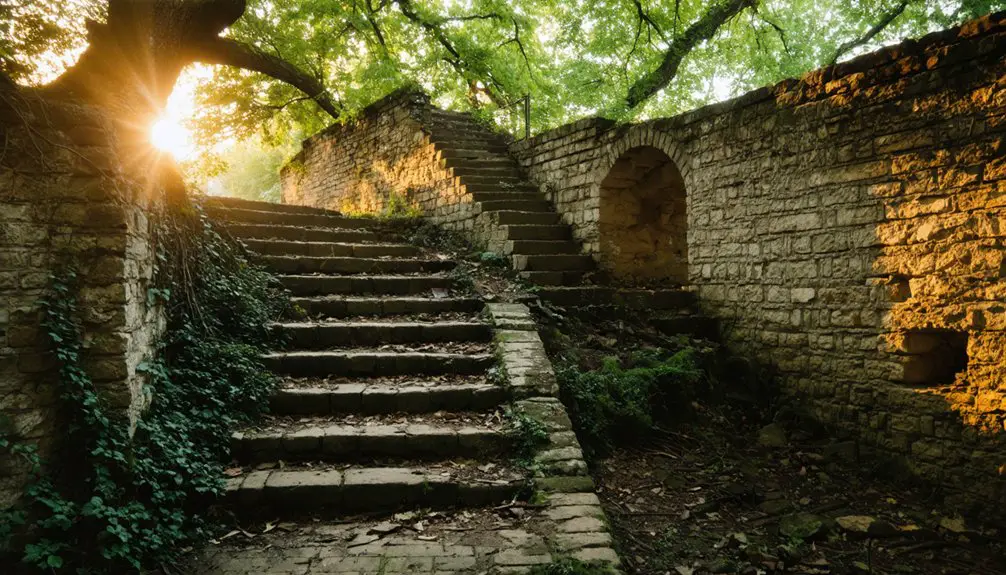You’ll find Quindaro’s ruins along Missouri River bluffs in Kansas City, where this 1850s free-state settlement once served as an essential Underground Railroad stop. Founded by abolitionists, Free Staters, and Wyandot tribal members, the town flourished with hotels, sawmills, and up to 36 weekly steamboats before declining after the 1857 economic panic. While nature has reclaimed most structures, the site’s scattered remnants whisper powerful stories of courage and resistance.
Key Takeaways
- Founded in 1856 as an abolitionist settlement, Quindaro rapidly developed with 100 structures before declining after the 1857 economic panic.
- Located along the Missouri River, Quindaro served as a key Underground Railroad station before becoming abandoned during the Civil War.
- The town’s remains include scattered building foundations, a preserved rock-cut steamboat landing, and archaeological artifacts from its brief existence.
- Economic competition from neighboring settlements and loss of town charter in 1862 contributed to Quindaro’s transformation into a ghost town.
- Nature has reclaimed most original structures, but preservation efforts continue to protect the site’s significance in Kansas’ anti-slavery history.
The Birth of a Free State Haven
While tensions over slavery gripped the Kansas Territory in 1856, a remarkable coalition of abolitionists, Free Staters, and Wyandot tribal members established Quindaro as a beacon of freedom on the Missouri River.
This strategic settlement emerged as a direct response to the Kansas-Nebraska Act, creating an essential free state port where anti-slavery settlers and escaped slaves could safely enter Kansas Territory. The Wyandot House Hotel became a crucial safe house for those seeking freedom.
The community foundations drew strength from the Wyandot Nation’s anti-slavery values, with the town’s name meaning “bundle of sticks” – a powerful symbol of unity.
These abolitionist alliances quickly transformed the landscape, building 100 structures in the first year alone. The bustling port saw up to 36 steamboat landings weekly by May 1857.
You’ll find the town’s rapid development was made possible by its natural advantages: a deep river ledge for steamboats, abundant timber, stone, and fertile soil for a thriving settlement.
Underground Railroad Operations and Safe Passage
When you look at Quindaro’s Underground Railroad operations, you’ll find a sophisticated network centered on the Missouri River crossing points, where freedom seekers would arrive under cover of darkness via small boats.
Once across the river, you’d see an intricate system of safe houses throughout the town, including hidden spaces like Clarina Nichols’ cistern that protected escapees from slave hunters. The town’s strategic river location made it an ideal crossing point for those escaping slavery in Missouri.
The town’s unified community of Native Americans, Black settlers, and abolitionists worked together to maintain these secret locations, providing shelter and sustenance until it was safe for freedom seekers to continue their journey westward. The Wyandotte Tribe initially established Quindaro in the 1850s as a gathering place that would become crucial to the Underground Railroad’s success.
River Crossing Network
The strategic location of Quindaro along the Missouri River, just above its confluence with the Kansas River, created a significant lifeline for enslaved people seeking freedom.
You’ll find that river navigation played an essential role, with steam ferries and steamboat traffic providing cover for clandestine crossings from Missouri into free Kansas territory. With up to 36 steamboats arriving weekly at the Quindaro landing, escaped slaves could easily blend in among the constant flow of passengers and cargo.
- Local ferry operations north of town helped disguise freedom seekers among regular passenger traffic
- Small boats and watercraft operated by trusted conductors facilitated covert nighttime crossings
- The bustling port’s commercial activity provided perfect cover for Underground Railroad movements
- Multiple crossing points near Quindaro allowed flexibility in escape routes
The river crossing network worked seamlessly with overland routes, creating a multimodal system that moved freedom seekers deeper into free territory or onward to Canada.
Secret Hiding Locations
Through an intricate network of safe houses and concealed locations, Quindaro’s Underground Railroad stations formed a significant lifeline for escaped slaves seeking freedom.
You’d find hidden shelters scattered throughout the town, from homes near Quindaro Creek to the secluded areas of “Happy Hollow.” The town’s natural geography, including riverside bluffs and wooded valleys, provided perfect cover for covert operations. The New England Emigrant Aid Company helped establish and support these freedom routes.
Key figures like Samuel Tappan, Clarina Nichols, and Benjamin Franklin Mudge risked their safety to maintain these secret locations.
Presbyterian minister Eben Blachly’s home doubled as both an educational center and refuge. The community’s dedication showed in their coordinated efforts to raise funds, provide food, and secure shelter – especially during harsh winters when escapees needed extended protection.
Local Wyandot tribe members and Free Staters united to support this essential mission.
Bustling River Port and Economic Growth
Strategically positioned along the Missouri River, Quindaro’s natural rock ledge created an ideal steamboat landing that transformed this settlement into a bustling commercial hub in 1856.
Despite economic challenges from pro-slavery steamboat operators, you’d have witnessed the port’s remarkable growth with up to 36 vessels docking in a single week. The town’s unique position between slave and free territories made it an essential Underground Railroad station for those seeking freedom.
Even facing fierce opposition, Quindaro’s bustling port defied expectations, welcoming dozens of steamboats weekly to its free-state shores.
The town’s cultural influences shaped its rapid development, featuring:
- Two thriving hotels catering to merchants and political figures
- Over 100 buildings, including the territory’s largest sawmill
- Essential trades like stoneyards and blacksmith shops
- Daily ferry service connecting to Missouri towns
As the only free-state port in the region, Quindaro’s commercial success helped break the monopoly of pro-slavery interests, establishing crucial supply lines that supported Kansas Territory’s growing free-state movement.
Pioneers in African American Education
Beyond its role as a free-state port, Quindaro’s most enduring legacy began in 1862 when Reverend Eben Blachly and his wife Jane opened their home to educate free blacks and escaped slaves. The educational initiatives operated as District #17 for black children. Their educational initiatives quickly grew into the Quindaro Freedman’s School, formally chartered in 1867 as the first black school west of the Mississippi River.
The school evolved into Western University by 1881, distinguished by its exceptional music department and teacher training programs. The Jackson Jubilee Singers became a renowned touring group that performed on the Chautauqua circuit nationwide.
You’ll find the community’s commitment reflected in the diverse support it received from local citizens, the state legislature, and church organizations. Notable graduates included cultural pioneers like Nora Douglas Holt and Eva Jessye.
The school’s impact extended far beyond Quindaro’s borders, training generations of African American educators and artists until financial challenges during the Great Depression.
From Thriving Township to Abandoned Ruins

While Quindaro’s promise as a bustling Free State port initially drew hundreds of settlers and merchants in 1856, the township’s dramatic rise would be matched by an equally stark decline.
The community dynamics shifted drastically as several factors converged to challenge this once-thriving haven of freedom:
- The devastating economic panic of 1857 struck just as the town was gaining momentum
- Fierce competition from neighboring Kansas settlements diminished Quindaro’s strategic importance
- Civil War tensions disrupted trade and settlement patterns
- Loss of the town charter in 1862 dealt a final blow to official status
You’ll find that by the mid-1900s, the historical significance of this freedom-focused community was visible only in its ruins.
Where steamboats once docked and abolitionists gathered, nature slowly reclaimed the abandoned buildings, leaving just scattered remnants of Quindaro’s bold experiment in liberty.
Preserving a Legacy of Freedom and Resistance
Today, when you visit the historic Quindaro site, you’ll find dedicated preservationists working to protect a remarkable legacy of freedom and resistance.
This once-thriving river town embodied community resilience through its diverse coalition of abolitionists, Free Staters, and Wyandot tribe members who united against slavery.
The historical impact of Quindaro resonates through time, having served as a vital Underground Railroad stop where escaped slaves found sanctuary.
Quindaro stands as an enduring testament to courage, where countless souls found freedom along the Underground Railroad’s dangerous path.
You can still sense the determination of those who defied the Fugitive Slave Law, operating up to 36 steamboats daily to aid freedom seekers.
The name “Quindaro” itself celebrates strength in numbers, reflecting the multiracial democracy its founders envisioned.
While the original buildings may be gone, preservation efforts guarantee that this powerful symbol of resistance and unity won’t be forgotten.
Frequently Asked Questions
What Indigenous Tribes Lived in the Quindaro Area Before Its Establishment?
Birds of a feather flock together! You’ll find rich tribal history in the Wyandot Nation’s territory, which they acquired from the Delaware Tribe. The Kansa, Osage, and Kickapoo peoples held cultural significance nearby.
How Many Escaped Slaves Successfully Passed Through Quindaro During Its Operation?
You’ll find exact numbers aren’t documented, but historic accounts suggest hundreds likely escaped through Quindaro’s significant slave routes, with Samuel Tappan’s 1858 letter noting “several persons” successfully crossing with “few accidents.”
What Specific Crops and Agricultural Products Were Grown in Quindaro?
You’d find wheat dominating the fields, while corn production kept folks fed. Local gardens burst with potatoes, beans, and peas. Nearby orchards supplied fresh fruits, supporting both settlers and freedom seekers.
Were There Any Notable Conflicts Between Quindaro Residents and Pro-Slavery Forces?
You’ll find significant Quindaro conflicts erupted when Border Ruffians blockaded river ports, sank the Parkville ferry, and confronted residents protecting escaped slaves. Pro-slavery resistance sparked frequent armed skirmishes along Missouri’s border.
What Happened to the Original Buildings and Materials After Quindaro’s Abandonment?
You’ll find virtually nothing left standing – zero building preservation occurred. Most materials were dismantled and repurposed locally, while remaining structures slowly decayed into ruins, now buried beneath a century of vegetation.
References
- https://en.wikipedia.org/wiki/Quindaro_Townsite
- https://www.kcur.org/politics-elections-and-government/2025-05-23/underground-railroad-site-in-kansas-city-kansas-named-national-historic-landmark
- https://kcyesterday.com/articles/quindaro-kansas-city
- https://kcindependent.com/quindaro-ruins-revitalization-to-bridge-the-past-and-present-for-future-generations/
- https://legendsofkansas.com/quindaro-kansas/
- https://www.travelks.com/kansas-magazine/articles/post/quindaro-a-great-nearly-lost-city-of-free-peoples/
- https://www.kckcc.edu/files/docs/ejournal/volume-one/number-one-oct-2007/quindaro-underground-railroad-a-unique-ethnic-unity-in-americas-past.pdf
- https://civilwaronthewesternborder.org/encyclopedia/quindaro-kansas
- https://en.wikipedia.org/wiki/Western_University_(Kansas)
- https://quindaro.kckschools.org/about/school-history



